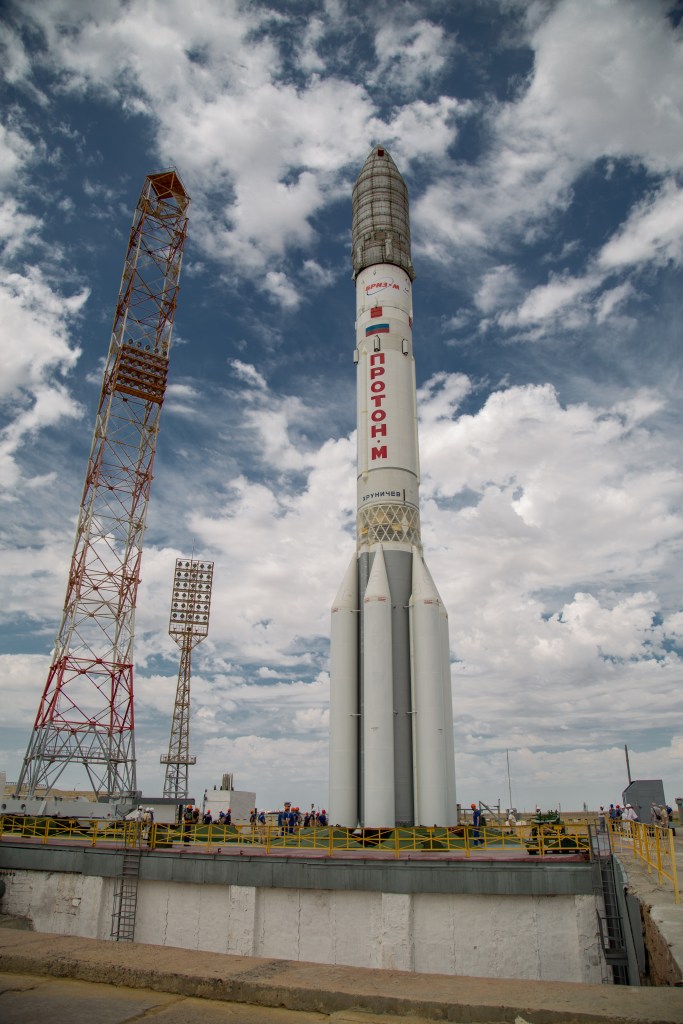Featured image credit: ROSCOSMOS/Yuzhny Space Center
Lift Off Time | October 12, 2022 |
|---|---|
Mission Name | AngoSat 2 |
Launch Provider | ROSCOSMOS |
Customer | AngoSat |
Rocket | Proton M/Blok DM-03 |
Launch Location | Launch Complex 81/24, Baikonur Cosmodrome, Kazakhstan |
Payload mass | ~ 1647 kg |
Where is the spacecraft going? | Geostationary orbit |
Will they be attempting to recover the first stage? | No, this is not a capability of Proton-M |
Where will the first stage land? | It will crash into the steppes of Kazakhstan |
Will they be attempting to recover the fairings? | No, this is not a capability of Proton-M |
Are these fairings new? | Yes |
How’s the weather looking? | TBD |
This will be the: | – 1st launch of Proton-M in 2022 – 113th mission of a Proton-M rocket – 134th orbital launch attempt of 2022 |
Where to watch | If available, an official livestream will be listed here |
What Does All This Mean?
The AngoSat 2 will launch atop the Proton M rocket, lifting off from the Baikonur Cosmodrome in Kazakhstan, replacing the failed AngoSat 1.
The AngoSat-2
The AngoSat 2 is an Angolan communications satellite built to replace the failed AngoSat 1. The satellite is part of the AngoSat Project which is working on developing communications satellites equipped with C- and Ku-band transponders which will operate in geostationary orbit, as well as developing ground communications and broadcasting infrastructure.
It was expected that the AngoSat 2 would be identical to the original AngoSat 1, however in August 2019 it was revealed that the replacement would be built by ISS Reshetnev (Bus) and Airbus Defense & Space (payload). The satellite has an expected lifespan of 15 years.
AngoSat 1
The AngoSat 1 was launched in December 2017 and successfully reached geostationary transfer orbit. While the satellite successfully separated from the rocket, communication was subsequently lost during solar panel deployment. Contact was reestablished the following day but the satellite had begun to drift out of its intended orbital position. In the following days it became clear that there was an issue with the electrical power system which had been causing the drift and it was then decided that no attempts would be made to maneuver the satellite back into its intended orbit.
What Is Proton-M?
Proton-M is a multi-use heavy-lift launch vehicle that first flew on April 7, 2001. It is capable to launch civilian and military satellites, as well as cargo missions to the ISS. This launch vehicle was developed and is manufactured by Khrunichev State Research and Production Space Center. Over the decades, several variants of the Proton rocket have been developed and flown over 400 times.
Compared to its ancestor, Proton-K, the Proton-M rocket has a new control system that not only enhances its power performance, but also improves its operational and environmental characteristics. For instance, it makes propellants utilization more efficient. It ensures that almost all fuel on the first stage of Proton-M burns up completely during ascent and the rocket crashes on land with empty tanks, which prevents contamination of the area.
The new system also provides a more controlled landing of the first stage. This has two benefits: easier debris recovery and reduced rent payment (the Baikonur Cosmodrome is located in Kazakhstan, where Russia leases the land). Moreover, it has larger payload fairings, which more than doubles available space for payloads.

The rocket consists of four stages, all of them are expendable. Proton-M is about 58.2 meters (191 ft) in height and 7.4 meters (24 feet) in diameter. The vehicle’s total lift-off mass is approximately 705,000 kg (1,554,000 lb). The rocket’s payload lift capacity to low-Earth orbit (LEO) is 22,400 kg (49383 Ib).
Stages
| First Stage | Second Stage | Third Stage | |
|---|---|---|---|
| Engine | 6 RD-276 | 3 RD-0210 and 1 RD-0211 | RD-0213 and RD-0214 |
| Total Thrust, kN / Ibf | 10,032 / 2,255,283, sea level | 2,354 kN / 529,200, sea level | 572 / 128,590Ibf, vacuum |
| Specific Impulse, s | 288, sea level 316, vacuum | 320, sea level 327, vacuum | 325, vacuum |
| Burn time, s | 121 | 211 | 258 |
First Stage
The first stage (21.2 m in length) consists of a central cylindrical part, which is an oxidizer tank, and six side-fuel tanks, each one of them is carrying an RD-276 engine. Unlike the four side-boosters on Soyuz 2 rockets, the ones on Proton-M are not detachable.
One interesting fact about the Proton-M rocket is that its design was greatly affected by the logistics. For example, the diameter of its oxidizer tank is the maximum that can be delivered to the pad by rail.

The RD-276 engine runs on a hypergolic propellant that uses dinitrogen tetroxide (N2O4) as an oxidizer and unsymmetrical dimethylhydrazine (UDMH, (CH₃)₂N₂H₂) as a fuel. Each one of these engines has one combustion chamber and together they are capable of producing a thrust of 10,032 kN (2,255,283 Ibf) at sea level, with an ISP of 288 s at sea level and 316 s in a vacuum. A burn time of this stage is ∼121 s. The RD-276 engines can control thrust vector by swiveling tangentially up to 7° from their neutral position.
Second Stage
The second stage is 17.1 m long and is powered by three RD-0210 engines and one RD-0211 engine. The engines on this stage start their ignition sequence prior to stage separation. This process is called “hot fire staging”. That is why the second stage is joined to the first one through an interstage with a lattice structure and not through a closed one. This design allows the exhaust to escape and also reduces the mass of the interstage. Each one of these engines has one combustion chamber, runs on UDMH and N2O4, and burns for 211 s. A total thrust produced by this stage is 2,354 kN (529,200 Ibf) with an ISP of 320 s at sea level.
Third Stage
Like the other two stages, the third one operates on UDMH and N2O4. It is 4.1 m long and is powered by one RD-0213 engine, and one RD-0214 engine. The RD-0213 engine has one combustion chamber and burns for 241 s, while RD-0214 has one combustion chamber, four nozzles, and a burn time of 258.3 s. An ISP of this stage is 325 s in a vacuum and a total thrust is 572 kN (128,590Ibf).
Fourth Stage
This particular launch will utilize the Blok DM-03 upper stage. This will be only the fourth launch of the Blok DM-03. The stage is powered by a single RD-58MF engine which burns RP-1 and LOX propellant.
Rocket section adapted from Mariia Kiseleva





